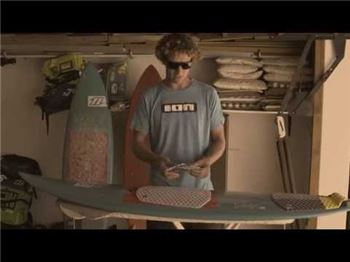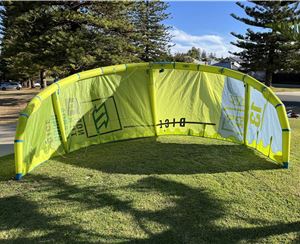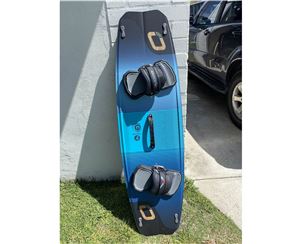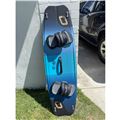How to make a Paulownia Kite Board
GDog took time to share this great story - awesome - check it...
Finally signed up to seabreeze to share a way of making your own kiteboard. Seabreeze was the first site I found when I googled "Kite surfing" over four years ago and took the forum's advice to get lessons first. This I did and have been obsessed with the wind ever since. Seabreeze also ignited my interest in making my own kiteboard after seeing some beauties on the forum pages. We don't really get waves inshore around Cairns, and since I have a few twinnies, I decided to try and make a skim style kiteboard. A few guys up here ride a Nobile skim board and love it so I based my board on this. The very first boards I made were out of normal 12mm plywood, had quad concaves, nose rocker and worked ok (one mate paid for the cost of fins and he is still the very happy owner of the first board on the left).

These boards were heavyish, had slow rebound and kind of doughy to ride so I decided to look at other options. After checking out a few wooden surf board sites I settled on Paulownia timber and found a supplier in Port Phillip. I spent ages dreaming and thinking about just how I was going to get a board with nose rocker without having to bend the timber. After much thought I finally had a plan.
I started out with 6 planks roughly 50 x 150 x 1600.

I halved 5 planks lengthwise to get 10 planks 50 X 75 X 1600 (even though I only show 9).

On each plank I drew the side profile of the board, which started paralell at 35mm thick then swept up at the nose to give me 75mm of nose rocker. I cut out this profile with a scroll saw for all 10 planks.

As these planks had to be glued together and clamped, I went to the hardware store and nearly died when I saw the cost of clamps. I ended up making the glueing jig pictured by welding some nuts to box section and screwing these to some battens.

All the profiled planks were lined up on the glueing jig to best fit each other and a quick plane of both sides was done to remove the rough sawn marks. I wasted alot of time looking for the best way to glue timber together and in the end visited a local fibreglass product supplier and bought a 2 to 1 epoxy used in the shipbuilding game.
The planks were glued together, clamped and left for 24hrs to set. Luckily I covered the timber battens in sticky tape and removed what excess epoxy I could otherwise I would be still trying to to get the planks from the jig.

After glueing, the board shape was drawn then cut out with a jigsaw. Edges were planed to close to finish dementions.

The top and bottom surfaces were planed to remove most of the excess material. The top of the board was going to be flat so the nose shape and deck were belt sanded to blend in the deck with the nose rocker. For the bottom of the board I wanted a single concave and this was sanded in with a 6 inch sanding pad in a drill. The drill pad gives a good result but ends up with alot of circular scratch marks that require heaps of hand sanding to remove (I bought a small random orbital sander for the second board and this helped). Once I was happy with the deck and bottom shape, a check was made on the outline symetry with some sanding done to adjust. I checked the outline by making a paper template and folding it in half, then trimming the bits that did not match.
The rail shape was done with a concave router bit to produce a soft rail all round.
Fin placement was a bit of a guess and a bit of a copy of the existing Nobile (longer screws were bought to make up for the thickness of the timber).
In the end the board is roughly 1600mm long and just under 500mm at its widest. The board has 75mm of nose rocker and 5mm of tail rocker. The bottom concave runs from the nose to the tail and is about 7mm at the deepest point in the middle. The board is close to 22mm at the thickest part.

To seal the board I used 4 hand brushed coats of a clear polyurethane but I am not too happy with the finish. I sanded between each coat and the final coat must have been too smooth for the polyurethane to stick to because it has been slowly coming off like gladwrap paper.


I used surfboard wax for grip to start with as some wind turned up and I was keen to give it a run. Straight away I felt the difference between this and my previous ply boards. This board planes fast, floats higher in the water and has a connected feel to it. I was in love but this did not mean much as I have no experience with this type of board. I gave the board to a few blokes that ride strapless and they said it was great fun. The criticisms were the lack of decent deck grip, fin angle and the tail slipping a bit in hard turns. Since then I have fitted the diamond deck grip and have redrilled the fins so they are more paralell. I have left the rail alone at this stage but will probably cut back the tail quarter at a later stage. I got a mate to airbrush a bit of art on the nose as well.



I have since nearly completed a fish style skim that is 1400 X 45 and down to about 20mm thick. This board was made from the waste of the first board and only has about 35mm of nose rocker.

I got a bit fancy and went from a single concave at the nose to a double concave at the tail. I made the tail quarter of the rail sharp with the rest rounded to the nose.

I have not stuck grip or tested this board as yet because we have had no wind and the top coat is still tacky. For this board I decided on a brushed polyester resin finish, still not happy with the end result. The next board will go to a professional to give it that glass look that I would like.

So far I have spent just under $1000, this incudes buying a scroll saw, power planer, random orbital sander, heaps of sandpaper, enough epoxy resin to build a ship, polyurethane clear, stainless crews, carton of beer for the buddha, fins and deck grip. I still have enough wood left to make the core of 2 twin tips but I would have to put some glass over these for strength.
In the end the experience has taught me heaps and kept me sane while we plough through our windless wet season. You could never get back the cost of labour for these boards but I think I have still got good value for money, 2 unique boards for under a grand. I will make more because now I have another addiction, at least this one does not need wind.














